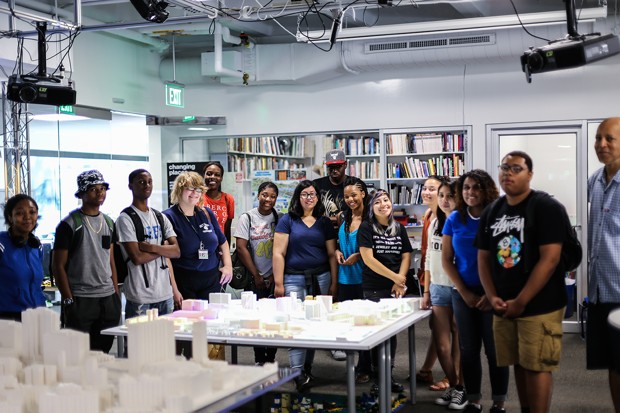Boston-area high schoolers built the LEGO model used in a recent series of workshops at MIT. (Ariel Noyman/MIT Media Lab via CityLab)
Since at least the early 1960s, when activist Jane Jacobs took on Robert Moses et al. in her seminal The Death and Life of Great American Cities, citizens, policymakers, and urban planners alike have puzzled over how to make the city planning process more inclusive, collaborative, and transparent. One obstacle to instituting effective grassroots planning is the gap between the technical tools and jargon-laden language used by professional designers and policy wonks, and the real-world experience of city dwellers.
Researchers at MIT are working to bridge this divide with LEGOs, the ubiquitous toy building bricks. In partnership with the Barr Foundation, the MIT Department of Urban Studies and Planning’s (DUSP) Mobility Futures Collaborative and the Changing Places group at the MIT Media Lab recently held a series of public workshops on the impact of Bus Rapid Transit systems on metro Boston. Workshop participants explored the future of BRT in Beantown using several newly-developed interactive planning tools, including the Changing Places group’s augmented reality city simulation CityScope.

CityScope transforms plastic building blocks into a powerful planning tool. (Changing Places group)
CityScope combines manipulable LEGO models of the urban environment with 3D projection to visualize planning impacts in real time. The CityScope “Reconfigure” prototype, for instance, encourages users to edit a digital model by moving LEGOs around a physical analogue. The prototype detects and scans changes for upload to the digital model, while the integrated projection component delivers instantaneous information on urban metrics including walkability and daylighting. Another prototype, “Scout,” focuses on land-use planning. As users slide LEGO-shaped tabs to adjust parameters including number of households and number of jobs and services, the resulting (digital) land-use map materializes at the opposite end of the table, in real time.
Innovations like CityScope represent an important check on the increased specialization that too often accompanies technological advancements including digital modeling. Grounded in a tangible, familiar medium—LEGO bricks—CityScope brings urban planning back to the people. “Our ultimate objective is this idea of co-creation,” DUSP associate professor Chris Zegras, who led the project team behind the BRT workshops told CityLab. “Having producers and consumers work intimately together in the production of a good creates a better good.”









